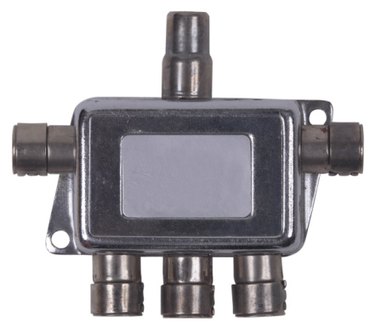
Cable splitters take a single incoming signal and send it to two or more outputs. They are commonly found in homes and businesses where more than one television is connected to a single coaxial TV cable. By dividing the signal, splitters weaken it, limiting the number of splits that can be installed on any one line without a signal amplifier. There are several basic types of cable splitters on the market.
Transformer Cable Splitters
Video of the Day
Transformer cable splitters divide the signal evenly to the output ports without much loss as it passes through the splitter itself.
Video of the Day
Resistor Cable Splitters
Resistors are cheaper components than transformers, making resistor splitters more cost effective than transformer splitters. Using a resistor splitter involves significant signal degradation, though, with 50 percent signal loss in the splitter and the other 50 percent of the signal divided amongst the outputs. (reference 1)
High and Low Frequency Splitters
Splitters for coaxial cable (the cable used for TV signals) are made to work with the 5-1000 MHz band used by modern digital cable signals, or the 5-2300 MHz band used by satellite TV signals. You can use high frequency splitters for low frequency cable signals, as their range includes the whole low frequency range. Low frequency splitters, however, can't be used for satellite signals.
Balanced and Unbalanced Splitters
All splitters have a certain amount of signal loss, which is measured in decibels (dB). The loss ranges from 3.5 decibels in a two-way splitter all the way to 14.5 decibels for a 16-way model. Splitters with even numbers of output ports will have a balanced output loss, in which all the ports output a signal with identical strength. Unbalanced splitters, by contrast, have odd numbers of output ports, some of which have less signal loss than others. Using an unbalanced splitter is useful if splitting a coaxial cable between one modem and several televisions, as the televisions don't need as much bandwidth.
Splitter Materials
Cable splitters commonly have housings which are either nickel-plated, chromate treated and zinc plated, or chromate treated with a zinc alloy added. The nickel-plated models are useful for outdoor installation in corrosive or salty environments, while the other types should be installed in an enclosure if placed outdoors. All of the material types will work inside.
Non-coaxial Cable Splitters
Cable splitters are available for almost any kind of audio, video, or data cable. In all cases, unpowered splitters will weaken the signal traveling in the cable by dividing it amongst several outputs. The weakening can cause problems for USB devices which take power from the cable itself, and for high-definition video connections using HDMI cables whose signals a split would degrade.